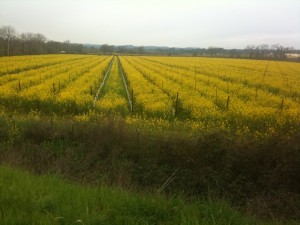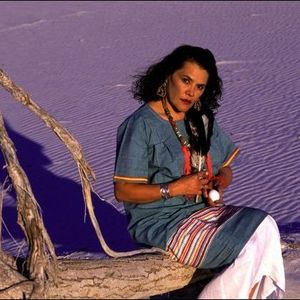 A while ago I had an interesting conversation with David Rickey over at www.SoulsCode.com. You can read our conversation about “A History of Consciousness, and How to Live in Presence” here. The next day, as I was riding my bike immersed in the beauty of the intense yellow, wild, blooming mustard juxtaposed against the spring green grass and robin’s egg blue sky I realized I had something more I wanted to share around duality, the ego and conscious connection.
A while ago I had an interesting conversation with David Rickey over at www.SoulsCode.com. You can read our conversation about “A History of Consciousness, and How to Live in Presence” here. The next day, as I was riding my bike immersed in the beauty of the intense yellow, wild, blooming mustard juxtaposed against the spring green grass and robin’s egg blue sky I realized I had something more I wanted to share around duality, the ego and conscious connection.
For many on the path of personal development the ego is viewed as something bad, something to transcend. However, I believe a well-functioning ego is essential to living a conscious, embodied, healthy life. My ideas about ego come from Bodynamic Analysis. They have a model of four ego aspects which is described below.
The Bodynamic system’s understanding of the ego operates with 4 ego aspects: body ego, individual ego, role ego and an observing ego. The body ego is the first ego aspect to be established, whereby we comprehend the world directly through our body senses and psychomotor experiences. The individual ego is established at 2 years of age and develops through individuation and separation processes. The individual ego is the part of us becoming aware of the fact that we as individuals are different from other individuals. The role ego starts developing when one is 3 years old. From then on we can adopt roles and apply them in a social context. Ideally, this new skill is established based on the sensation of being me in my body, and on acknowledging me as a separate individual. The 3 ego aspects are integrated in a healthy ego development. The observing ego has a purpose with respect to all 3 ego aspects. In this level of the ego, we can observe what we do while we are doing it. The ego, as we use the term, is the overarching and collective concept that includes all 4 ego aspects.¹
For me, this model works very well both personally and professionally. It has helped enhance my self-understanding as well as my understanding of others. It has also aided me in my own personal healing process.
I am not endeavoring to take on an explanation of the spiritual experience of union, or oneness except to acknowledge that it exists in a place outside of ego. Bodynamic sometimes refers to this place as the bigger Me.² I believe we can have blissful, spiritual experiences of oneness while we are physically embodied, but that attaining complete immersion into everything else is not a place a physical body can reside in permanently. Our bodies are not permanent.
For me, the development of the observing ego is what is key to creating a larger awareness of connection between  ourselves and others. The observing ego helps me see the bigger picture rather than just my own personal needs. It helps me to have some space between my impulses and my actions. And, in a dualistic world, I believe this space is where we gain access to that sense of oneness with all life. In my experience, being able to contain in my own system two extreme opposites opened up a space inside me where energy could flow at great intensity. Holding those opposites at the same time kept me from flipping from one side of duality to its polar opposite. One of my teachers, Curandera Elena Avila, expressed this concept beautifully in a poem she wrote.
ourselves and others. The observing ego helps me see the bigger picture rather than just my own personal needs. It helps me to have some space between my impulses and my actions. And, in a dualistic world, I believe this space is where we gain access to that sense of oneness with all life. In my experience, being able to contain in my own system two extreme opposites opened up a space inside me where energy could flow at great intensity. Holding those opposites at the same time kept me from flipping from one side of duality to its polar opposite. One of my teachers, Curandera Elena Avila, expressed this concept beautifully in a poem she wrote.
Woman That Glows In The Dark
I woke up to my illusions,
and now I can’t sleep.
I have no desires
and now I can’t eat
what you dish out to me.
I’ll stay awake forever if I have to.
I live in the crack of an egg.
In the space
between galaxies and earth mud.
Along the thin borders
of enlightenment and darkness.
I saw through the smoky mirror,
and my third eye winked at me!
Time is an illusion,
and eternity lives
in the cracks of everything
that is dualized.
I like living in the middle of
either/or
and gray is my color
in black/white.
I’m cozy in the nucleus of past/future and
I am the ember seed in light/dark.
I am Woman that Glows in the Dark.
I’ll stay awake forever
if I have to.³
Elena passed away this year. She was a mother, healer, teacher and woman of integrity. I am honored I had the privilege to apprentice with her.
Notes
1. Merete Holm Brantbjerg, Ditte Marcher, and Marianne Kristiansen, Resources in Coping With Shock, A Pathway to a Resource-Oriented Perspective on Shock Trauma (Copenhagen: Kreatik Publishing, 2006) p. 25.
2. Brantbjerg, Marcher and Kristiansen, pp. 25-31.
3. Elena Avila with Joy Parker, Woman Who Glows In The Dark (New York: Jeremy P. Tarcher/Putnam, 1999) n. pag. opposite contents.
© Carole LaRochelle, 2009.



Vedantic spiritual teachers would agree with you. It is important to have a “juicy,” well-functioning ego to move forward in spiritual life. Glad to be introduced to the Bodynamic breakdown of the ego-self into body ego, individual ego, role ego and an observing ego. It seems to be a good way to analyze and work with healthy ego development. What is also said to be true is that the ego-self is but a dim and distorted reflection of the True Self on a part of the mind. The whole purpose of spiritual life is to purify, unify, and transform the mind so that the Self can be realized as it is in Itself–pure and infinite.
Hi Meryl,
I’m currently reading The Great Oom:The Improbable Birth of Yoga in America by Robert Love. This is the story of Pierre Bernard, the first American yogi, who was trained extensively by a Tantric yogi named Sylvais Hamati. Ida Rolf was a student of Bernards in the 1920s. Around the turn of the 20th century Bernard was living in San Francisco. He befriended Swami Vivekananda in the spring of 1900 when he passed through San Francisco. Love has some interesting things to say about Bernard and the first wave of Indian swamis who arrived in the United States. He says, “[these] westernized swamis differed from Bernard on a fundamental point: their yoga was not of the body, but rather an ascetic, Christianized yoga, influenced by British Victorian morals and the ideas of the Theosophical Society. Following the prejudices of his upbringing, Vivekananda in fact criticized hatha yoga as dangerous and unnecessary to enlightenment. The nascent network of Vedanta schools he built as he traveled around the country all subscribed to this nonphysical notion of yoga.”
Ready to get embodied now?